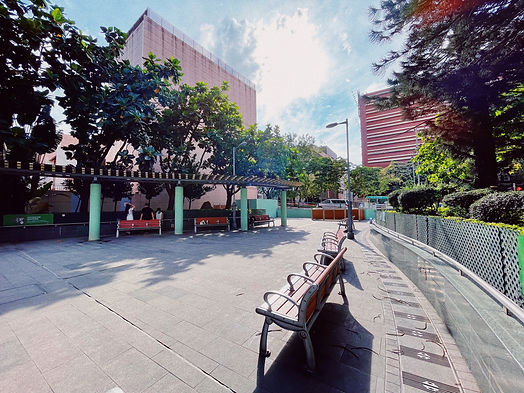
023
位置圖 Location
紅菱街休憩處
Hung Ling Street Sitting-out Area
隨著九廣鐵路總站和海底隧道的落成啟用,鄰近的紅磡區發展潛力在70年代越見可觀。80年代早期,黃埔船塢業權交接後,搖身一變成為住宅發展區。到80年代末、90年代初,紅磡灣填海工程展開,進一步改寫了紅磡曾為工業區勞工階層社區的角色,邁向中產生活區。紅菱街休憩處的前身,則是填海工程前的紅磡碼頭公共巴士站,在九廣鐵路通車後,巴士總站為渡輪、火車和巴士乘客提供一站式接駁服務,直至1991年跟隨碼頭搬離。休憩處目前為寵物公園,入口�南北對開,以一條波浪形涼亭貫穿,東西兩邊則佈有南洋杉和芒果樹樹列,但由於周邊殯儀館林立和黃埔街重建,公園顯得較為冷清。
In the 1970s, with the completion of the Kowloon–Canton Railway Terminus and the Cross-Harbour Tunnel, the development potential of the neighbouring Hung Hom was ever-increasing. After the transfer of ownership of the Hong Kong and Whampoa Dock in early 1980s, Hung Hom was transformed into a residential development area. By late 1980s and early 1990s, Hung Hom Bay’s reclamation further pushed Hung Hom away from its previous role as an industrial, working-class community, slowly becoming a middle-class area. The predecessor of the Hung Ling Street Sitting-out Area was the Hung Hom Ferry Pier Public Bus Terminus before the reclamation. The opening of the Kowloon–Canton Railway transformed the bus terminal as a one-stop connection point for all ferry, train and bus passengers, until it followed the pier’s relocation in 1991. Currently, the sitting-out area is a pet park, with entrances on north and south ends. A wave-shaped pavilion runs through the middle, with rows of Norfolk Island pine and mango trees lined on east and west sides. However, the park appears to be relatively deserted due to nearby funeral homes and the reconstruction of Whampoa Street.

剖面圖 Section

軸測圖 Axonometric








